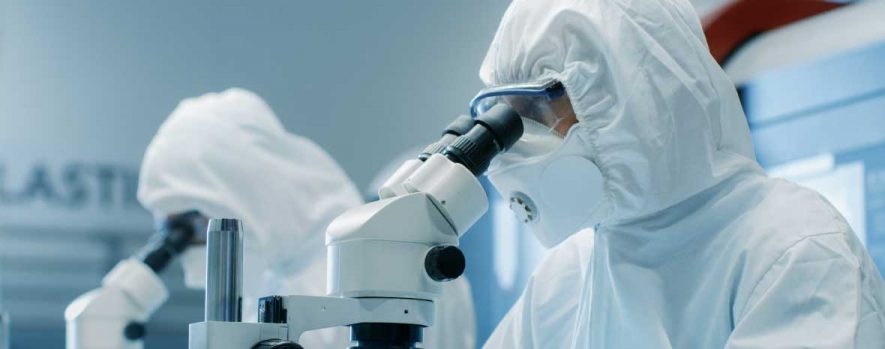
Whether working in healthcare, manufacturing, food and beverage, or a variety of other industries, protecting staff and products in a controlled environment is very important. It may seem like the terms clean and sterile are used interchangeably, but when it comes to disposable protective clothing used in controlled environments, there is a difference between clothing that is clean and clothing that is sterile. Read on to find out more about the differences between these products.
Clean vs. Sterile
Both clean and sterile garments are made for use within a controlled environment. Clean clothing provides a protection for the wearer due to its liquid and particulate barrier. International Enviroguard's Microguard CE products are microporous protective garments that are clean.
Sterile clothing goes beyond clean clothing; after sterile clothing is manufactured, it undergoes a sterilization process to remove threats of contamination in a controlled environment. Sterilization minimizes the possibility of life forms and transmissible agents remaining on sterilized products after undergoing sterilization. These life forms include microorganisms, bacteria, spores, funguses, and viruses. Some sterile products, such as GammaGuard disposable protective clothing, are clean-processed.
Clean processing means that loose particles remaining after the sterilization process are removed, lessening the chance of contamination in a cleanroom. Sometimes these clean-processed products are referred to as "low linting." In order for a product to be deemed clean-processed, it has to go through a clean-manufacturing process in which manufacturing employees are gowned in cleanroom attire, the manufacturing area is appropriately disinfected, and the addition of particulates to products is highly controlled. It is important for you to consider your disposable clothing needs to understand if clean, sterile, or clean-processed sterile garments are needed in your controlled environment.
Now that we're more familiar with what it means for a product to be clean, sterile, and/or clean-processed, let's dive in to learn more about the types of and importance of sterilization.
Types of Sterilization
The two most common types of sterilization in single-use products such as disposable clothing are gas sterilization and gamma irradiation. In each of these sterilization processes, products are exposed to the gas or gamma rays in a sterile environment for a predetermined amount of time, typically between minutes and hours.
Gas sterilization is more formally known as ethylene oxide or EtO sterilization. Ethylene oxide is a highly flammable, volatile, and toxic gas, though it is often diluted with other gases during the sterilization process to make it more controllable. This type of sterilization takes places in a vacuum, and the gas' temperature, humidity, and concentration are monitored and customized depending on the product that is being sterilized. Though this sterilization process is effective on a variety of products, even those that are pre-packaged, drawbacks include the gas' toxicity and carcinogenic nature, smell and discoloration of materials, and need for control for many variables during the process.
Gamma sterilization is more effective than gas sterilization and costs less to implement. In this process, products are exposed to ionizing radiation, also known as gamma rays. This process works because the gamma rays break covalent bonds inside the DNA of microorganisms such as bacteria and viruses living on the surface of the article being sterilized. Breaking these bonds causes the cell to eventually die, eliminating the microorganism. This process is overall safer than gas sterilization because the process does not cause heat, moisture, or residual radiation. Currently, gamma sterilization is the most widely used sterilization method in industrial plants and the pharmaceutical industry.
Importance of Sterility Levels
Just because an object is sterilized does not mean that there is one standard criteria for sterilization. Instead, there are multiple levels of sterilization. Different uses for sterilized products call for different levels of sterilization, often referred to as Sterility Assurance Level, or SAL. For instance, the SAL of 10-3 is acceptable for use in industry, while a product with a SAL of 10-4 meets criteria for most medical tools. A SAL of 10-6 s the standard for medical instruments entering the body as well as for sterile cleanrooms utilized by pharmaceutical companies during drug manufacturing. Let's break down what these numbers mean a little further.
An easy way to look at the SAL is to think of the superscript number as the number of rounds of sterilization an object has gone through, also known as log reduction. It is estimated that one round of sterilization kills 90% of microorganisms on an object. Though this percentage is high, it is not hard to understand how even 10% of leftover bacteria, viruses, and microorganisms could cause contamination in a variety of settings. Each subsequent round of sterilization continues to destroy 90% of the microorganisms by one order of magnitude less. We can think of this as there being one million microorganisms on an unsterilized object prior to sterilization. With 10% of microorganisms remaining, that brings the total to 100,000 and then to 10,000 after the following round, then to 1,000, to 100, and then to 1 once you get to round four or more of sterilization.
Though it is impossible for an object to become 100% sterile, repeating the sterilization process over and over decreases the viability of the microorganisms left behind after sterilization. Though the industry standard for sterile disposable clothing is a SAL of 10-6, International Enviroguard's GammaGuard sterile disposable clothing has a SAL of 10-6, drastically reducing the amount and viability of microorganisms on this sterile and clean-processed clothing. As you consider your needs for disposable clothing, consider the degree to which you require sterilization as well as whether clean or clean-processed sterile goods are appropriate for your needs.